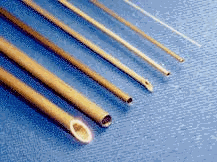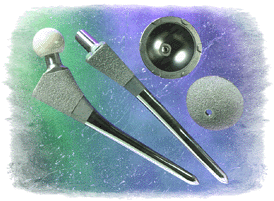Shape memory materials (SMMs) are featured by the ability to recover their original shape from a significant and seemingly plastic deformation when a particular stimulus is applied1. This is known as the shape memory effect (SME).
A shape-memory alloy is an alloy that can be deformed when cold but returns to its pre-deformed ("remembered") shape when heated. It may also be called memory metal, memory alloy, smart metal, smart alloy, or muscle wire.
Parts made of shape-memory alloys can be lightweight, solid-state alternatives to conventional actuators such as hydraulic, pneumatic, and motor-based systems. They can also be used to make hermetic joints in metal tubing.
Shape memory alloys (SMA) are materials that “remember” their original shape and can go back to this original shape after deformation under a stimulus. They are also known as smart alloys or memory metals. SMAs were first reported by Arne Ölander in 1932. He observed that a gold-cadmium alloy can be bent when cool, but it can return to its original shape when heated. However, it was not until William Buehler and Frederick Wang of the US Naval Ordnance Laboratory developed a nickel-titanium alloy in 1962 that could go back to its original shape upon deformation that these materials caught on. This alloy was commercialized as nitinol and since then SMAs have become a popular choice in a variety of fields such as aerospace, civil engineering, and biomedical devices. Some SMAs can go back to a shape different from their original shape under a stimulus, thus holding two different shapes and are called two-way SMAs.
Properties of Shape Memory Alloys
The reason why only some metals show the shape memory effect is because of a reversible change in their crystal structure. SMAs have two different phases with different crystal structures and so different properties, a high temperature phase called martensite and a low temperature phase called austenite. Contrary to a typical transformation that involves the diffusion of atoms, the phase change in SMAs occurs by a shear lattice distortion, which makes the change reversible.
Applications
SMAs also show a property called superplasticity, whereby they show almost rubber-like behavior. This property finds use in spectacle frames. SMAs can produce a large deformation compared to most other metals. In addition, they are also superelastic, which means they can recover from relatively large strains of about 7%, although there is some hysteresis present. This dissipation of energy by SMAs finds applications in vibration dampers.
SMAs have been used in a wide variety of applications spanning diverse industries. Apart from the flexible spectacle frames mentioned above, they can be used in bioengineering applications such as dental wires such as those used in dental braces, mending broken bones using metal plates, and for medical devices that help open clogged veins and arteries. They are used as wires and tubes in applications with hot fluids flowing through them. These materials are ideal as they can retain their shape even in a heated environment.
Another application of SMAs is in civil engineering. For example, they have been used in bridge structures. SMAs can dampen vibrations, hence tuning the natural frequency of various structures. This property of vibration damping has also been used in launch vehicles and jet engines. Newer lightweight alloys have also been discovered, such as magnesium-scandium that can have a variety of potential applications such as in aerospace applications and the medical industry for biodegradable self-expanding stents.
SMAs can also also used as actuators because of their ability to change shapes and have potential applications in aircraft and space vehicles because they are lighter and can help save energy compared to bulky mechanical actuators. Earlier this year, NASA demonstrated a nickel-titanium SMA actuator used in folding the outer portions of wings during flight. This change in the angle of the plane’s wings according to wind and turbulence helps reduce energy use.
Another possible application of SMAs is in retrofitting buildings that are not designed considering seismic conditions. Here, the ability of SMAs to undergo large deformations with very little residual strain as well as their ability of reversible shape change with hysteresis is used. A beam column joint can be retrofitted with reinforced concrete using pre-stressed SMA wires. This significantly increases their shear strength and axial loading capacity, compared to wires that are stressed only when the concrete starts expanding.
In a latest discovery, researchers have increased the operating temperatures of high temperature SMA, from about 400 °C up to about 700 °C. They achieved this by combining four or more metals to form the shape memory alloys. One potential application of SMAs with high operating temperatures could be in decreasing airplane noise when coming into an airport. The SMAs could automatically change the size of the exhaust nozzles depending on the temperatures encountered during the various flight stages.
Although there are already a vast number of applications for SMAs, newer alloys are being discovered with different properties and there seems to be even more applications that these materials can be used in the future.
Bioengineering:
v Bones: Broken bones can be mended with shape memory alloys. The alloy plate has a memory transfer temperature that is close to body temperature, and is attached to both ends of the broken bone. From body heat, the plate wants to contract and retain its original shape, therefore exerting a compression force on the broken bone at the place of fracture. After the bone has healed, the plate continues exerting the compressive force, and aids in strengthening during rehabilitation. Memory metals also apply to hip replacements, considering the high level of super-elasticity. The photo above shows a hip replacement.
v Reinforcement for Arteries and Veins: For clogged blood vessels, an alloy tube is crushed and inserted into the clogged veins. The memory metal has a memory transfer temperature close to body heat, so the memory metal expands to open the clogged arteries.
v Dental wires: used for braces and dental arch wires, memory alloys maintain their shape since they are at a constant temperature, and because of the super elasticity of the memory metal, the wires retain their original shape after stress has been applied and removed.
Anti-scalding protection: Temperature selection and control system for baths and showers. Memory metals can be designed to restrict water flow by reacting at different temperatures, which is important to prevent scalding. Memory metals will also let the water flow resume when it has cooled down to a certain temperature.
Fire security and Protection systems: Lines that carry highly flammable and toxic fluids and gases must have a great amount of control to prevent catastrophic events. Systems can be programmed with memory metals to immediately shut down in the presence of increased heat. This can greatly decrease devastating problems in industries that involve petrochemicals, semiconductors, pharmaceuticals, and large oil and gas boilers.
Golf Clubs: a new line of golf putters and wedges has been developed using_____. Shape memory alloys are inserted into the golf clubs. These inserts are super elastic, which keep the ball on the clubface longer. As the ball comes into contact with the clubface, the insert experiences a change in metallurgical structure. The elasticity increases the spin on the ball, and gives the ball more "bite" as it hits the green.
Helicopter blades: Performance for helicopter blades depend on vibrations; with memory metals in micro processing control tabs for the trailing ends of the blades, pilots can fly with increased precision.
Eyeglass Frames: In certain commercials, eyeglass companies demonstrate eyeglass frames that can be bent back and forth, and retain their shape. These frames are made from memory metals as well, and demonstrate super-elasticity.

The photo to the right demonstrates flexible eyewear.
Tubes, Wires, and Ribbons: For many applications that deal with a heated fluid flowing through tubes, or wire and ribbon applications where it is crucial for the alloys to maintain their shape in the midst of a heated environment, memory metals are ideal.

Different sizes of NiTinol tubes




No comments:
Post a Comment